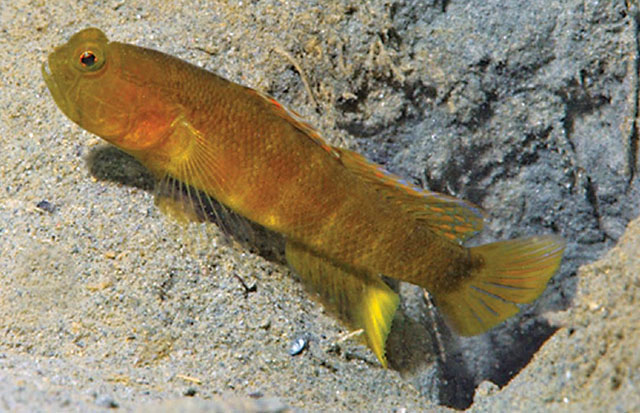| Gobiidae (Gobies), subfamily: Gobiinae |
| 5 cm SL (male/unsexed); 3.42 cm SL (female) |
|
benthopelagic; marine; depth range 12 - 15 m |
| Western Pacific: Papua New Guinea. |
|
Dorsal spines (total): 7-7; Dorsal soft rays (total): 10-10; Anal spines: 1-1; Anal soft rays: 9-9. Dorsal-fin rays VI-I,10; anal-fin rays I,9; pectoral-fin rays 15; scales in longitudinal series 47; median predorsal scales 19; body scales entirely cycloid, including abdomen, and prepelvic region; pectoral-fin base and head naked except side of nape and predorsal region; preopercular-canal pore N absent; gill opening extending forward to a vertical at posterior edge of preopercle; seventh and eighth anal-fin rays prolonged, resulting in distinctly pointed posterior anal-fin profile; longest anal-fin rays 1.1 in HL; caudal fin rounded, longer than head, 3.1 in SL; pelvic fins relatively short, not reaching posteriorly to anus, 4.7 in SL; color of female generally golden brown with six faint dark bars from nape to caudal-fin base, interspersed with yellowish, slightly narrower interspaces; both dorsal fins with vertical, dark-edged orange markings between each spine and ray, interrupted to form spots on outer half of fin; second dorsal fin with pale blue submarginal stripe; anal fin dusky yellow brown, except posteriormost portion (encompassing last three rays) bright yellow; caudal fin is yellow to brownish with longitudinal blue streak between most rays of middle portion; pelvic-fin rays are dusky brownish; male (not collected, but presumed to be the same species) with 4 oblique and narrow orange bands (usually wavy and interrupted) on the cheek and opercle and have more vivid dark bars on body (Ref. 116711). |
| The area of collection consists of moderately sloped (ca.20 degrees) mud substratum, where the slope begins in approximately 1.5 m depth and flattens out at about 18 m. The featureless bottom have numerous burrows occupied by a variety of fishes and invertebrates, including Cryptocentrus epakros. Three individuals (the female holotype, a presumed male, and another female) were observed in 12.5-15.0 m depth. Each individual was invariably associated with an unidentified alpheid shrimp (colour overall is pale greyish with bright pink legs and a pink claw with a bluish tip). The female holotype was in close proximity (about 30 cm) to the presumed male, which occupied a separate burrow (Ref. 116711). |
|
Data deficient (DD); Date assessed: 14 November 2023 Ref. (130435)
|
| harmless |
Source and more info: www.fishbase.org. For personal, classroom, and other internal use only. Not for publication.
